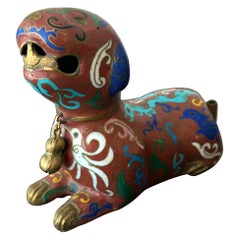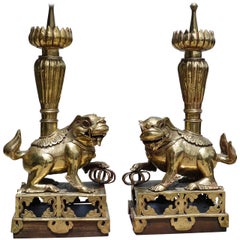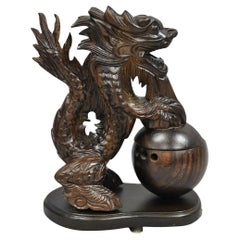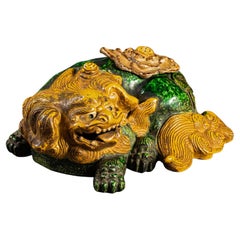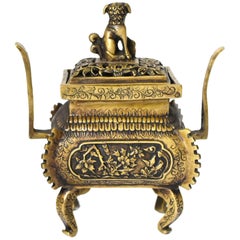Foo Dog Incense Burners
Vintage Japanese Cloisonne Enamel Champleve Bronze Foo Dog Incense Burner
Located in Philadelphia, PA
Vintage Japanese Cloisonne enamel champleve bronze foo dog incense burner. Item features lid with
Category
Early 20th Century Chinoiserie Vases
Materials
Bronze
Vintage Brass and Enamel Foo Dog Incense Burner Form Qing Dynasty
Located in West Palm Beach, FL
Introducing our "Vintage Brass and Enamel Foo Dog Incense Burner from the Qing Dynasty." This
Category
Mid-20th Century Chinese Qing Candle Sconces
Materials
Metal, Enamel
Pair of 19th Century Chinese Bronze Foo Dog Lamps
Located in Kilmarnock, VA
A striking and sculptural pair of mid-19th century Chinese bronze foo dog incense burners, later
Category
Antique Mid-19th Century Chinese Qing Table Lamps
Materials
Bronze
Decorative Carved Wood Chinese Foo Dog Dragon Incense Burner Holder
Located in Philadelphia, PA
Decorative Carved Wood Chinese Foo Dog Dragon Incense Burner Holder. Circa Late 20th Century
Category
Late 20th Century Unknown Chinoiserie Animal Sculptures
Materials
Wood
Foo-Dog 'Shi-Shi' Incense Burner 'Koro' with Removable Lid
Located in Hudson, NY
This unique piece of ceramic has beautiful color. It also has a collector's box.
Category
Antique 19th Century Japanese Ceramics
Materials
Ceramic
Chinese Song Dynasty Blue Glazed Foo Dog Lion Incense Burner Figure
Located in Forney, TX
,
featuring early primitive molded sculptural form, the figural censer depicting a foo dog guardian lion on
Category
Antique 15th Century and Earlier Chinese Han Ceramics
Materials
Earthenware, Pottery
Art Déco German Painted Porcelain Foo Dog Perfume Lamp/Incense Burner by Aerozon
By Aerozon
Located in North Miami, FL
Art Déco german hand-painted glazed porcelain foo dog perfume lamp/incense burner by Aerozon
By
Category
Mid-20th Century German Art Deco Table Lamps
Materials
Enamel
$1,300
H 7.5 in W 6.5 in D 4 in
Recent Sales
Japanese Bronze Shishi Lion Foo Dog Small Incense Burner, 1960s
Located in Paris, FR
Japanese bronze censer with lion foo dog (Shishi).
In japan, censer is one of the three Buddhist
Category
20th Century Japanese Showa Antiquities
Materials
Bronze
Brass Incense Burner with Foo Dog
Located in Somis, CA
A beautiful, fully decorated incense burner. The burner has curved legs, a bombay style main
Category
20th Century Chinese Metalwork
Materials
Brass
Antique Patinated Iron Foo Dog Incense Burner
Located in San Diego, CA
Antique patinated iron foo dog incense burner, circa early 1900s. The head is removable to load
Category
Early 20th Century Chinese Figurative Sculptures
Materials
Iron
Antique Patinated Iron Foo Dog Incense Burner
Located in Greer, SC
Wonderful antique patinated iron foo dog incense burner, circa early 1900s. The head is removable
Category
Early 20th Century Chinese Other Metalwork
Materials
Iron
Antique Iron Foo Dog Censer
Located in Somis, CA
An original 19th century iron foo dog incense burner. Well-fashioned in a standing position
Category
Antique 19th Century Chinese Qing Metalwork
Materials
Iron
Bronze Tripod Censer Foo Dog Lion Incense Burner
Located in Somis, CA
A beautiful antique bronze incense burner in the Ming dynasty style. The vessel's bulbous sides are
Category
Early 20th Century Chinese Ming Urns
Materials
Bronze
Huge Cloisonné Incense Burner with Dragon and Foo Dog
Located in Somis, CA
A giant cloisonné incense burner.
This is a very substantial bronze cloisonné piece. It
Category
20th Century Chinese Metalwork
Materials
Bronze
Brass and Copper Foo Dog Figural Incense Burner Sculptures
Located in Miami Beach, FL
These 20th century adorable foo dogs have green glass eyes and are made of brass and copper. The
Category
20th Century Asian Animal Sculptures
Materials
Brass, Copper
Pair Chinese Foo Dog Incense Burners
Located in Sheffield, MA
Pair small Chinese porcelain Foo dog incense burners, enameled on the biscuit, both with balls
Category
Antique 19th Century Chinese Figurative Sculptures
Pair of Tibetan Encrusted Turquoise and Coral Foo Dogs
Located in Jupiter, FL
Intricately detailed pair of hand crafted metal Tibetan foo dog incense burners. Each foo has been
Category
Early 20th Century Tibetan Tibetan Animal Sculptures
Materials
Metal
People Also Browsed
Pair of Carved Wood Foo Dog Lamps by Sarreid
By Sarreid Ltd.
Located in Stamford, CT
A pair of carved wood Foo Dog lamps by Sarreid of Spain. Shaped black paper lamp shades with gold interiors. Dogs are seated on black painted wood bases. Dogs alone are 5 inches wide...
Category
Vintage 1970s Spanish Chinoiserie Table Lamps
Materials
Wood
$1,280 Sale Price / set
66% Off
H 25.5 in W 7.5 in D 11 in
Get Updated with New Arrivals
Save "Foo Dog Incense Burners", and we’ll notify you when there are new listings in this category.
Foo Dog Incense Burners For Sale on 1stDibs
At 1stDibs, there are several options of foo dog incense burners available for sale. Each of these unique foo dog incense burners was constructed with extraordinary care, often using metal, bronze and brass. Foo dog incense burners have long been popular, with older editions for sale from the 19th Century and newer versions made as recently as the 20th Century.
How Much are Foo Dog Incense Burners?
Prices for foo dog incense burners can differ depending upon size, time period and other attributes — at 1stDibs, foo dog incense burners begin at $225 and can go as high as $8,500, while the average can fetch as much as $1,263.
More Ways To Browse
Chinese Censor Bronze
Chinese Jade Foo Dog
Chinese Tripod Bronze Censer
Komainu Dog
Chinese Copper Incense Burner
Chinese Lion Statues
Foo Dog Clock
Foo Dogs Made In Japan
Vintage Ceramic Lion Figurine
Elkins Lamp
Foo Dog Figurine
Heron Bronze Vase
Ming Dynasty Urn
Satsuma Foo Dog
Signed Asian Porcelain Urn
Chinese Figurine Dog Foo
Dog Perfume Lamp
Jade Foo Dog

